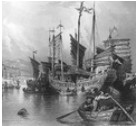| |
| Mother of Pearl History Legends & Lore |
| Time:2012/12/24 |
| |
 In Asia, centuries before the birth of Christ, the Chinese learned that beads or tiny figures of deities slipped between the soft mantle and the shell of a living mollusk soon became coated with Mother of Pearl. These beads and carvings were then taken to the temples and offered to the gods in the hope that they would bestow good luck upon the donor. Mother of Pearl, like jade, soon held a position of high status in Chinese society and became interlinked with stories of gods and mythical creatures. ?/div>  One such story is the tale told in the Tao classic 'The History of The Great Light', written by Huai-Nan-Tzu during the Han dynasty at the beginning of the first millennia A.D. In the book there are eight stories of eight mortals who, through their good deeds, were rewarded with everlasting life. The eighth of these stories tells the tale of Ho-Hsien-Ku, who was instructed in a vision that if she ate Mother of Pearl she would gradually become immortal. She did as the vision instructed, living in the mountains and eventually dispensing with mortal food. Ho-Hsien-Ku started to float from peak to peak becoming more and more ethereal, finally attaining her quest she was renamed 'The Immortal Maiden' symbolized in the Tao philosophy by the lotus flower. ?/div>  During the Confuciusan 'Tang' dynasty, as Buddhism spread to Korea and Japan, China absorbed and unified a vast territory that had formerly been divided into North and South China. The 'Tang' dynasty, lasting from 600 A.D. to 900 A.D., was a period of widespread prosperity and trade that stretched from inner Asia to the archipelagos of South East Asia. With the promise of great wealth, many mariners and merchants from all over the Pacific were attracted to China, bringing with them precious cargos of Pearls, Mother of Pearl and many other precious and semi-precious gemstones. ?/div>  In ancient China Mother of Pearl, apart from finding its way into rings and necklaces, was used in profusion as a decorative inlay in ornaments such as vanity mirrors and brushes, and in later centuries would feature heavily as an inlay in Chinese and Korean furniture. Interestingly, the Chinese also used Mother-of-Pearl in medicine, prescribing it for over a thousand years as an aid to reduce heart palpitations, dizziness, and high blood pressure. |
|
|
| |
|
|
|